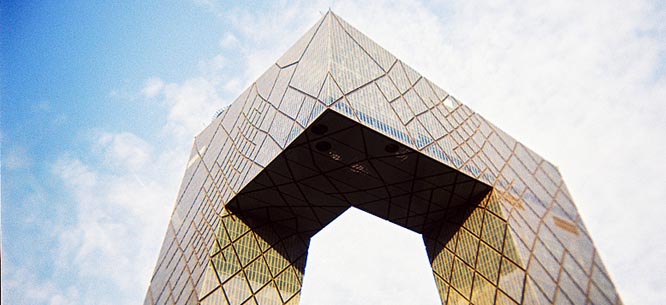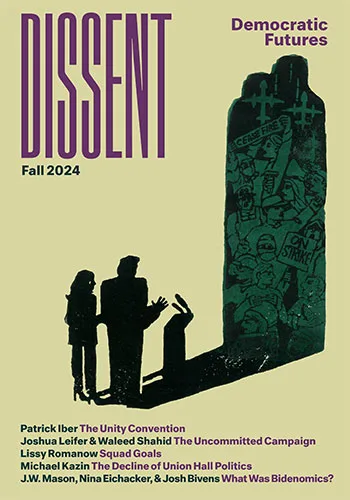Yes I Said Yes I Will ¥€$: Koolhaas in China
Yes I Said Yes I Will ¥€$: Koolhaas in China
The CCTV Headquarters constitutes Koolhaas’s attempt to mitigate the pervasive banality he associates with the present. It is probably his masterpiece.

I was standing on a rooftop just inside Beijing’s Second Ring Road when Rem Koolhaas’s Television Cultural Center caught fire. It was February 9, the last day of the 2009 Chinese New Year and the last day Beijing residents were allowed to detonate fireworks within the city. These final hours unfold a spectacular display as all of Beijing erupts in a do-it-yourself Saturnalia of sparks and phosphorous. It is a sight I would go to see every year if I could. As we watched the show, someone noticed a column of red light to the east. Through all the smoke, it was not immediately apparent what we were seeing, but slowly the realization came: this was a disaster; a skyscraper, maybe an entire city block, was burning.
Before the 2008 Beijing Olympics, an attack by Muslim separatists from Xinjiang or a massive protest for Tibetan freedom had seemed almost as plausible as two weeks of games that would go off without a hitch. (In the end an American man was stabbed to death by a disturbed Chinese national, but little was made of it in the papers.) Was this fire somehow related? I went inside and turned on the television. There was nothing. The local anchor continued her rundown of that day’s mundane happenings. It was unclear whether she even registered the catastrophe.
The irony of the media blackout was piquant, even for Beijing. Adjacent to the tower-cum-torch was Koolhaas’s other contribution to Beijing’s skyline, an awing hexagonal donut that was to be the new headquarters of China Central Television, the broadcast side of Chinese state media. The building was unfinished and unoccupied at the time, but the fire could not have occurred in a location more conspicuous to the network. As the tower blazed on the doorstep of their new home, CCTV execs must have been scrambling to keep the story off the air.
Of course, the news did come out—first in the international press and then, finally, in China. A skyscraper cannot burn to cinders in the capital without someone noticing. But what exactly had happened was never made clear. The story only grew more baroque: a contractor with illegal fireworks smuggled in from Hebei; an errant rocket that shot through the titanium-zinc wing comprising the roof and two sides of the structure; or perhaps some of the fireworks did not detonate as they were supposed to and were stashed inside the tower, where they then did. I have never seen a conclusive report. There was only a tangle of rumors from which to extrapolate.
This is a familiar pattern for anyone who has followed the various tragedies and mishaps that take place within the purview of the Chinese press: baby formula spiked with melamine, public schools that collapse on their students during an earthquake, high-speed trains that careen into one another, carbolic acid spilled into rivers, forced evictions, self-immolations, unrest in Xinjiang, riots in Tibet, extrajudicial detention, and the whole slew of local protests that together make up the largest underreported story in China. The year 2012 alone has added to this list a raft of sex scandals involving CCP officials and, infamously, the Bo Xilai affair, for which only the most preposterous accounts have been offered. The conflagration in Koolhaas’s tower was unique only in its scale and centrality. For a time, this made it the proxy for all those other disasters smoldering across China.
The fire and the subsequent non-investigation are part of a series of events that made a farce of liberal fantasies imposed on the Beijing Olympics. The commission was secured in 2003 and brought with it promises of greater freedoms. Journalists were to have access to government officials. Protest was to be allowed. (A photograph from that time by Wang Qingsong gets at the mood. The artist, in the guise of an English teacher, points at a giant chalkboard behind him that is covered in slogans. McDonald’s and Nike logos are there, but so are “SARS,” “Venice Biennale,” and “Enjoy peace. Enjoy the Olympics!” Across the top of the frame are the words: “Let China walks [sic.] toward the world! Let the world learn about China!”) These promises came to naught, and while the international press clamored loudly about Beijing’s various deceptions—partly out of genuine concern, partly because the Olympics introduced the world to a China that was powerful enough to fear—their fulminations meant less and less as the fact of the Olympic games eclipsed the turning point it was supposed to be.
Instead, the legacy of the Beijing Olympics is a massive hardware upgrade for the city’s security apparatus and a slew of fiercely contemporary architectural projects. In addition to Koolhaas’s complex, Norman Foster created a third terminal for Beijing’s airport, Paul Andreu gave the city the unlovely National Center for the Performing Arts, and the Swiss team Herzog & de Meuron, with assistance from the artist Ai Weiwei, designed the main Olympic stadium. Together these showpieces have given Beijing the status they were intended to impart. The meandering hutong alleyways of the old city, like termite trails carved through miles of low-slung gray brick, are what make Beijing memorable. But the reason former Times architecture critic Nicolai Ouroussoff has written that China is “leaving the West in the dust”—it is Koolhaas and his cohort.
Based on any moral code recognizable as such, Koolhaas’s decision to build a headquarters for a vital cog in the state’s propaganda machine was questionable. Indeed, it was criticized along predictable lines when he won the commission in 2002. Ian Buruma, for one, wondered in a Guardian editorial what made China different from Pinochet’s Chile or Saddam’s Iraq? Why was it OK to build in one country and not the others? (Buruma’s conclusion: it wasn’t.) Chinese intellectuals and students also took issue with his plan. One scholar in particular claimed in an essay that the building’s novel form resembled a bent-over woman. He was convinced that a Westerner was once again trying to feminize China. More recently, the artist Ai Weiwei has called CCTV employees “terrorists” and described Koolhaas’s tower as an occupying presence. To these accusers, Koolhaas’s reply has been, essentially, that they don’t get it. He has never claimed to be running his firm by a moral compass. (“The good,” he has said, “is not a term that interests me.”) Nor, for that matter, was he among those hoping to bring an end of history to China. His project was of a piece with the Olympics, but the vision he had for the CCTV complex, and for China, was grander and far more idiosyncratic.
Subtending Koolhaas’s decision to build in Beijing was a feeling of disgust with mass culture and free-market capitalism that came to a head in the early aughts. In 2002, the same year he won the commission for the CCTV complex, he published an essay called “Junkspace.” It takes the form of an obsessive list of definitions, in the vein of Susan Sontag’s “Notes on ‘Camp.’” Junkspace, narrowly defined, is the opposite of what Koolhaas means by architecture. Lacking substance and form, “it is subsystems only, without superstructure, orphaned particles in search of framework or pattern.” But junkspace is not a technical term. It fuses with Koolhaas’s anxieties about suburbanization, Americanization, malls, air conditioning, casual Fridays, and vast cultural leveling to become something more symbolically vivid. Junkspace is “kindergarten grotesque,” “mini-Starbucks on interior plazas”; it “is like being condemned to a perpetual Jacuzzi with millions of your best friends.” What emerges is a conflicted blend of angst, glibness, Western Marxism, and arch patrician contempt.
As the piece staggers toward its conclusion, the political message grows more pronounced:
Junkspace pretends to unite, but it actually splinters. It creates communities not of shared interest or free association, but of identical statistics and unavoidable demographics, an opportunistic weave of vested interests. … Its financing is a deliberate haze, clouding opaque deals, dubious tax breaks, unusual incentives, exemptions, tenuous legalities, transferred air rights, joined properties, special zoning districts, public-private complicities. Funded by bonds, lottery, subsidy, charity, grant: an erratic flow of yen, euros, and dollars (¥€$).
The anti-capitalist sentiments above should not be taken at face value. Koolhaas’s politics are aesthetic. His distaste for junkspace and the free market stems from their lack of structure. Class struggle does not factor.
Koolhaas has never claimed to be running his firm by a moral compass. (“The good,” he has said, “is not a term that interests me.”)
What stirs him instead is the prospect of a manifesto. Koolhaas cherishes the utopian strain in architecture, the audacity to project into the future a vision of a different world and to build toward it. He scorns the serenity of Falling Waters in favor of Brasilia, Soviet Constructivism, and Corbusier. The politics behind these schemes comes secondary to the promise they make—that architecture can make meaningful interventions in the social fabric; that it, like revolution, can change the way we live. Since he published his first book, Delirious New York, in 1978, Koolhaas has labored to revive this quintessentially modernist aspiration. His “retroactive manifesto” envisions the skyscraper’s archetype incubating in Coney Island’s amusement parks—where electric lights, air-conditioning, and elevators were first given free rein—before leaping the East River to infect the 2,028 blocks of Manhattan’s grid and initiate the city’s skyward pilgrimage. New York’s contribution and its triumph was in counterposing to Europe’s sober modernism “an unformulated theory, Manhattanism, whose program—to exist in a world totally fabricated by man, i.e., to live inside fantasy—was so ambitious that to be realized, it could never be openly stated.”
There’s evidence, though, that in retrospect Koolhaas sees Delirious New York—a coup that made him famous before he had completed a single building—as a bit of a Pyrrhic victory. “There are no more manifestoes—only books about cities that imply manifestoes,” he complained in a discussion with Denise Scott Brown and Robert Venturi, authors of the classic Learning from Las Vegas. Beneath this remark lies Koolhaas’s interpretation of his profession’s recent history. What used to be about the group and the movement devolved, sometime around the 1970s, into a celebration of virtuosic acts of personal creativity. Now, in place of Corbusier, there are only Gehry-like starchitects and the incessant Guggenheims inflicted on us with each new museum. The sacrifice of vision for sculptural novelty has made architecture trial for Koolhaas. Talking about its ebb can turn him lachrymose. “We were making sandcastles,” he said during his acceptance speech for the 2000 Pritzker Architecture Prize. “Now we swim in the sea that swept them away.”
A similar sentimentality animates his latest publication, Project Japan. The book is a paean to the Metabolists, a group of Japanese architects associated with Tange Kenzō that was active from the early 1960s through the seventies. Their sketchbooks reveal thickets of apartment buildings skewered atop pilotis like so many lollipops and towers comprised of stacked capsules with one porthole per room. Koolhaas calls them “the last movement to change architecture,” “a Japanese avant-garde that engineered its appearance on the world stage 50 years ago and disappeared 25 years later in the bonfire of neoliberalism.”
The CCTV Headquarters constitutes Koolhaas’s attempt to mitigate the pervasive banality he associates with the present. It is probably his masterpiece. Two towers rise up, titling perilously toward one another before breaking at right angles some thirty-six stories in the air. They meet in such a way that the connecting section hangs out, cantilevered in empty space, its underside with unobstructed views of the ground below. There is no sense of counterbalance. The building stands only by virtue of enormous tension, which Koolhaas has emphasized by choosing to show a web of steel supports on its exterior. They become denser in the places that bear the most stress. One of the architect’s greatest points of pride is that he thinks he has built the first skyscraper that is not phallic. The kinked O that the CCTV tower forms from certain angles, in fact, suggests a cubist vulva.
But the importance of this building for Koolhaas is not only a matter of shape. It is “China”—that this building was successfully completed there and now defines the skyline of its capital—that gives the CCTV tower its significance. Koolhaas spent four years of his childhood in Jakarta and is fond of saying that during that time he lived like an Asian. (I heard him make this claim during a talk last year at the New York Public Library, but like most things he says, you can find a written version somewhere. In this case, it’s in S, M, L, XL, a massive catalogue of thoughts, impressions, pie charts, and blueprints from two decades of labor by his firm, the Office of Metropolitan Architecture.) In the 1980s and 90s, when he was flying to Tokyo regularly and building apartments in Fukuoka, he imagined that these four years gave him special insight into Japan. He even composed waka to the architect Toyo Ito:
Toyo
Thank you
for comparing me to a “mechanical baseball pitching machine.”
Only from a Japanese
such a compliment
would not be an
insult.
Maybe there is
a certain efficiency in my character,
but in Europe
it is very dangerous
to admit
that you don’t have a soul.
Now that China looms largest in the east, Koolhaas’s empathetic link with Asians has transmigrated to the mainland. His Japan is heavily filtered through French theory—an Empire of Signs à la Roland Barthes. China, however, belongs to the economists. It means careening growth and the ravages of the market unleashed on a former plan economy. To hone in on this phenomenon, Koolhaas and a group of his students from the Harvard Graduate School of Design traveled to the Pearl River Delta at the turn of the century. There, in the heart of China’s Special Economic Zones, cities grew en masse from former cropland. Shenzhen, now one of the key nodes of Chinese finance, didn’t have a building over five stories in 1979. By 1995, more than two hundred towers with over eighteen stories punctuated its skyline. This is the China that dominates Great Leap Forward, a silly fat red book published in 2001 that contains the findings of Koolhaas and his team. The title comes from its authors’ thrill in the juxtaposition of the Chinese government’s fanatic dedication to development and its Maoist past. Koolhaas and his students never seems to tire of pointing out the ways that one was reborn as the other. They even coined a word for it, INFRARED©, explained thus: “Communist ideology in China retreated underground, tunneling and ramifying according to the opportunistic potentials of its vision. Utopia mutated into reform—the sub-visionary but effective tactic of compromise.” (A stylistic curiosity of Great Leap Forward is the barrage of jargon it employs. A glossary in the back lists nearly a hundred terms like INFRARED©, each rendered in red majuscule and each with its own copyright symbol, indicating the word’s connection to capital investment.)
Below the semantics, the researchers find a cityscape teetering on the edge of disaster. “While the high-priced commodity buildings are over-supplied,” writes one investigator, “private developers do not construct enough hospitals, factory dormitories, and affordable housing for which there is an urgent demand.” This is as sober as the book’s tone gets. Much of the rest comes off as a studied way of not grasping the obvious. Observing that a single Chinese architect is made to design in seven days what an American firm would require two to three months to complete, the conclusion is: “These transformations prove that the classical disciplines of planning and design are no longer viable. Architecture is not the known and familiar, but has transformed into ARCHITECTURE© coincident with capital, speed, and quantity.” Or there’s FENG SHUI©, which “dictates that paradise can be constructed using 10 thousand tons of loaded explosive to level a mountain” and build bungalows.
It’s worth noting that this is not simply a warmed-over triumphalist narrative of Chinese capitalism. The essays in Great Leap Forward find continuity where others have cast Deng Xiaoping’s reforms as a radical break from the past. Nor are they very starry-eyed about the benefits of capitalism, which is portrayed as an ideology like any other. It’s more a matter of being indifferent to its iniquity and enamored by its power. All the markers that nauseated Koolhaas in “Junkspace” are there: the speed and scale of development that obliterate any attempt at rational design, collusion between developers and the state, unsavory funding, and the tackiness that swells between the gaps. In China, though, junkspace is invested with something other. It bears possibility, while in the West it was barren.
“The context of BIG is fuck context,” Koolhaas wrote in S, M, L, XL. By this he means that no matter what occurs around or on top of a truly massive structure, so long as it dwarfs its surroundings, the form it constitutes will endure. Change continues, but it cannot erase what is truly BIG. A version of this idea inspired Koolhaas in his student days to draw up a project proposal that depicted London sundered by a gargantuan wall with enough room on top of it for swimming pools and public parks. That project had much to do with youthful irreverence—the allusion to the wall dividing Berlin at the time was unmistakable. But Koolhaas’s interest in bigness has not dissipated one bit since then. Instead, bigness has become a philosophy, “the lingering hope—that shape, form, coherence could be imposed on the violent surf of information that washes over us daily.”
In the CCTV complex, bigness is twofold. The main tower encompasses some 400,000 square meters of space. Before the fire, the Television Cultural Center added to the complex another 75,000 square meters of multi-purpose property. Together it was enough for every facet of China Central Television’s production, plus a five-star hotel, a shopping center, and a theater that could accommodate 1,500 people. The shape of Koolhaas’s centerpiece adds to the impression of size. The way the CCTV tower rears up only to double over again imbues it with an organic aura, as if it was not a building but an enormous body. The reference points by which one measures a standard skyscraper are subverted this way. Though the CCTV tower does not reach the heights of its neighbors, it looms in a way they do not from far away; from close up, it monopolizes one’s field of vision. What was growing into a dull, standard-issue business district now possesses a little more edge. As a monument, a stand-in for the power of China and most especially the state, Koolhaas’s building has done its job.
But if the CCTV complex is big, it’s nowhere close to being big enough. In comparison to its setting—where there reigns a party that cares little about the nuances of the built environment, where the conjuncture of developer’s capital and state power has enabled the destruction of China’s past at a scale unimaginable even during the Cultural Revolution, and where the struggle over what can and cannot be said is being waged online, not over a monolithic and increasingly outmoded television station—in comparison to China, which is BIG, Koolhaas’s work does not even factor. The bent-loop shape of the building is awing but only visible within a small radius of the Central Business District, and then only on the days that pollution does not choke the air. (Fire, of course, substantially enhances its visibility.) In actuality, Koolhaas’s CCTV complex is a small thing—a monument, an ornament for China’s capital, and a novel working environment for CCTV employees. Had he not built it, Toyo Ito or one of the other luminaries who submitted designs for the competition would have, and Chinese development would have continued apace.
This is not an exculpation of Koolhaas or his building. News dies there and is turned into agitprop for a regime that seems to stand for nothing so much as its own perpetuation. Despite his facility with words, Koolhaas has found none to address this truth in a meaningful way. He demurs, and in doing so shows that if his attempt to stand outside of common sense stems from a personal theory about the purpose of architecture, no small share also belongs to cowardice. The CCTV complex is divorced from him now, though. Koolhaas has moved on, but it stays, a symbol of outsize vision: the perennial idea that the mass segment of humanity that China contains is capable of changing the world, and the impotence of an individual (even an architect) in the face of such magnitudes.
Colin Jones is doctoral candidate in history at Columbia University.





